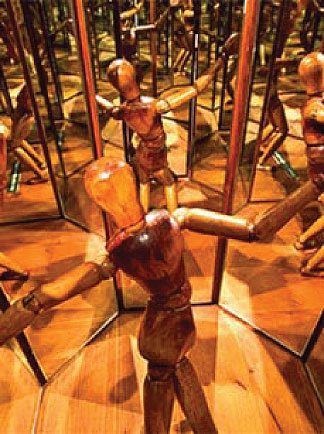Wait, Was that a Selfie?
Think the selfie is a modern invention? Long before your cell phone, artists used the camera obscura to paint portraits of... themselves.
Leonardo da Vinci may have been painting portraits—and self-portraits—centuries before the invention of the modern-day camera, but we speculate he used another kind of camera that was well-known to artists of his day, the camera obscura. However, as an inventor and scientist, Leonardo may have raised the technique to a new level.
The camera obscura is a dark box, or a very dark room with a very small hole in one wall, that lets in light. Directly across from the hole an image from the outside world—in this case, a human model—is projected onto the wall upside down. This phenomenon occurs because, while light travels in a straight line, when some of the rays reflected from a bright subject pass through a small hole, they become distorted and end up as an upside-down image.
Leonardo, who was obsessed with learning about human anatomy and regularly dissected eyes from corpses to learn the secrets of sight (a critical capacity for an artista!), noticed precisely how the human eye perceives objects: light reflects off the surface of the object you are looking at and travels through a small opening on the surface of the eye (your pupil), but the image ends up flipped upside down.
In one of his notebooks, he observed, No image, even of the smallest object, enters the eye without being turned upside down. Leonardo didn't have the tools at the time to figure out how a human eye sees the image right-side up. He didn't know what we know, that the eye's optic nerve transmits the image to the brain, which then flips it right-side up. He didn't know what we know, that the eye's optic nerve transmits the image to the brain, which then flips it right-side up.
What the camera obscura needed was a brain to flip the image!
Beyond Obscure
But the Maestro had other secrets to capture those amazing portraits right-side-up from the get-go, a technique he kept from competitors like Michelangelo and Botticelli.

He set up a system of mirrors to be able to paint his subjects (and his own portrait) from different angles, including the ability to draw his self-portrait in three-quarters view, a first.
Want to Learn More?
- "A Journey through the Human Eye" TED, TED-Ed, 30 Nov, -0001. https://ed.ted.com/featured/iWB9F1Ia. Accessed on 1 Jun, 2018.
- Haunty. "Leonardo Da Vinci's Camera Obscura" OwlCation, 21 Dec, 2016. https://owlcation.com/humanities/Leonardo-da-Vincis-Camera-Obscura. Accessed on 3 Jun, 2018.
- Heydenreich, Ludwig Heinrich. "Leonardo Da Vinci" Encyclopedia Britannica, Encyclopedia Britannica, Inc., 11 Apr, 2019. https://www.britannica.com/biography/Leonardo-da-Vinci/Anatomical-studies-and-drawings. Accessed on 7 Jun, 2019.
- Hoffman, Donald. "Do We See Reality as It Is?" TED2015, 1 Mar, 2015. https://www.ted.com/talks/donald_hoffman_do_we_see_reality_as_it_is. Accessed on 11 Jun, 2018.